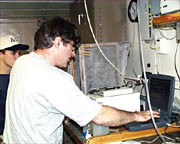|
|
Interviews: Chief
Scientist George Luther
|
 George looks at some new Chemical Scanner data from a core to determine how to slice up the sediment. Question:
How did you become interested in science? What did you think you wanted to be when you were a boy? George: I always wanted to be a chemist. I had a chemistry set, which I experimented with all the time. As usual, some of the experiments didn’t work. My parents were always understanding and supportive of my interests in science, even when I made messes in the garage and basement with my chemistry. Question: Where did you go to college and graduate school? How did you start doing the research you are now involved in? George: I went to a small four-year college, LaSalle College, where I majored in chemistry. In 1972, I got my Ph.D at the University of Pittsburgh. I did rocket-fuel research for a while in graduate school, but finally settled on research involving the new field of nuclear magnetic resonance (NMR) spectroscopy. After graduate school, I taught at a small college. While I was there, I got involved in collaborative research with some marine geologists in New Jersey who were studying heavy metal toxicity in the sediments of Newark Bay. I loved doing the fieldwork and applying my knowledge of chemistry to the environment, so I gradually directed my research more and more in that direction. Much of my work now involves environmental sciences and aquatic toxicity studies. I try to figure out how trace elements (elements that occur in nature but in small amounts) affect geochemical and biological processes. I’m a detective of sorts. I try to figure out how organisms, big and small, use these trace elements and how these elements affect their life processes. The work we are doing here at Guaymas Basin and at other mid-ocean ridge hydrothermal sites is helping us understand the interactions between biological systems and very harsh, toxic environments. Question: How much time do you spend at sea each year? Do you like being in the field? George: It varies each year. This year I will spend about twenty days on the water. Over the years, I have been at sea in many different regions, including the Arabian Sea, the Mediterranean Sea, and the Black Sea. I love travelling to various historical and religious sites when I go on field trips. That has been a real treat for me. Question: What do you like best about your work? What do you like least? George: I love doing research in the field and laboratory. I also love undergraduate teaching. I miss doing that now that I teach mostly graduate students. I also enjoy seeing my students develop and mature as they move along in their careers in science. It is gratifying to see young scientists excited about solving problems. Question: What are your hobbies? George: I love music of all kinds. I love to participate in and watch team sports. One of my favorite things to do as a teacher is to perform chemical magic shows for children of all ages, from one to 92. Chemistry is fun. It involves almost everything we do on a daily basis, from what we eat, to the things we use, to the technology that makes our lives easier. Question: What research problem do you have your sights set on for the next decade? George: I want to continue working in marine chemistry, on hydrothermal vents as well as on other topics. Other interests include coastal processes and the interactions between biology and chemistry. I am investigating how marine organisms take up trace elements. These elements are essential for their survival, but can be toxic if the organism gets too much of them. This work has important applications for improving industrial processes, both in how they are designed and how they can lessen their impact on the environment.
|
|
© 2010 Dive and Discover™. Dive and Discover™ is a registered trademark of
Woods
Hole Oceanographic Institution

 George
is excited about one of the microbiological cultures that
came from samples collected using Alvin.
George
is excited about one of the microbiological cultures that
came from samples collected using Alvin.